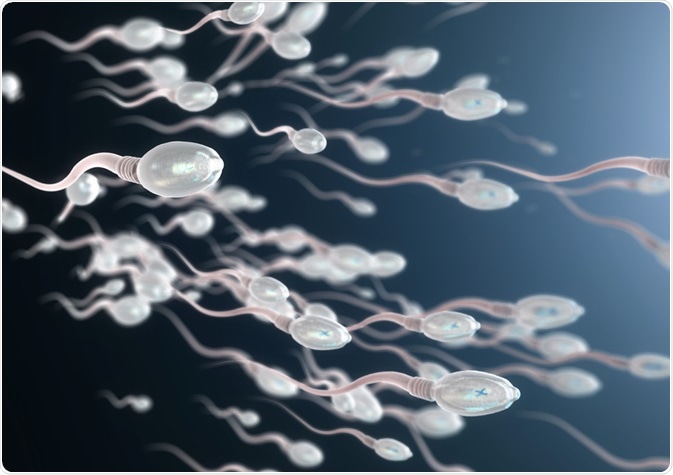Male infertility is defined as the inability of a male to impregnate a female, despite trying to for at least one year. In couples struggling to conceive, one out of three times the root cause of infertility lies with the man.
There can be multiple reasons for male infertility, which may include physical problems with the testes, blockage in the sperm-carrying ducts, genetic disorders, hormonal imbalance and lifestyle-related factors.
Ongoing research is aimed at identifying the cause of male infertility as well as testing solutions that may resolve male infertility. The American Center for Reproductive Medicine has a number of research projects dedicated to male infertility, some of which are discussed here.
Current research results
Spermatozoa of men with male infertility issues have higher levels of DNA damage. The damage appears as single and double-strand breaks, modification of the base or inter-strand cross-links. While the DNA damage has been documented, the cause is not understood. Current research points to (OS) and dysregulated apoptosis as key factors.
Oxidative Stress refers to the imbalance between the antioxidant capacity of the seminal plasma and the production of reactive oxygen species (ROS) by the sperm and leukocytes. The condition causes the number of immature sperm with residual cytoplasm to increase. ROS are free radicals that are detrimental to proper the development of spermatozoa.
Dysregulated Apoptosis results in low-quality semen, due to low sperm count and malformation of the sperm cells. The spermatozoa also tend to have higher levels of DNA damage when the process of apoptosis does not keep a check on the germ cells to ensure that they are within the limit of the Sertoli cells.
Currently, a hypothesis is being tested to check if these two factors, OS and dysregulated apoptosis, are related. Experiments are being conducted to check how apoptosis can result in DNA damage. This will enable researchers to devise prevention and treatment methodology.
 Image Credit: Christoph Burgstedt / Shutterstock.com
Image Credit: Christoph Burgstedt / Shutterstock.com
Other research being conducted on male infertility
Effect on semen due to exposure to electromagnetic waves
Mobile phones, laptops, and other electronic gadgets that use electromagnetic waves have become an essential part of our daily lives. Research is being conducted to assess the effect electromagnet waves have on sperm count, motility and morphology.
Ejaculated semen placed near a mobile phone for an hour has shown a decrease in sperm viability and motility. There is an increase in the ROS levels and a decrease in ROS-TAC (reactive oxygen species-total antioxidant capacity) when it is compared to semen that was not exposed to electromagnet waves.
Since many males carry their mobile phones in their pant pockets or in holders on their belts, their testicles are being exposed constantly to a high density of electromagnetic waves. This will lead to a detrimental effect on the male reproductive organs, to an increase in damaged sperm, and eventually male infertility.
Effect of temperature on sperm during centrifuge semen processing
Male infertility is often treated by using Assisted Reproductive Techniques (ART) processes. A common treatment for low sperm count involves separating the spermatozoa from the semen ejaculated to obtain a higher concentration of sperm.
The process used for the separation is a benchtop centrifugation. However, the benchtop centrifuges used in ART are not temperature regulated. Spermatozoa are affected by temperature and so should there be a high temperature during the process, it is likely that the sperm quality is lowered.
Research is currently being conducted to evaluate the effect of temperature on human semen centrifugation. Various factors related to the spermatozoa are recorded to check how regulating the temperature during centrifugation can prevent damage to the sperm.
Effect of vitrification on spermatozoa
Freezing sperm is an essential technique often used in ART treatments of infertility. The idea is to preserve the spermatozoa by storing them after freezing for later use. The process is called sperm cryopreservation.
Currently sperm cryopreservation is done by slowly freezing the sperm, but a new technique called vitrification is under trial. Vitrification is a faster freezing process that tends to avoid ice crystal formation due to the rapid shifting of sperm from liquid to solid-state.
Research is being conducted to check how sperm fare after vitrification when they are thawed. The effect of vitrification on sperm viability and motility is being validated. Should it prove beneficial, the extent of DNA damage caused by slow freezing may be reduced using vitrification in the future if the post-thaw sperm parameters are better.
Other research projects on male infertility are being conducted to evaluate the extent of DNA damage in infertile men, the effect of lycopene on spermatozoa, using proteomic analysis to understand sperm dysfunction and much more. There are many aspects of male infertility that are not understood and this research may help us learn more about the concern. Image Credit: Image Point Fr / Shutterstock.com
Image Credit: Image Point Fr / Shutterstock.com
Reviewed by Afsaneh Khetrapal BSc (Hons)
References
- https://medlineplus.gov/maleinfertility.html
- https://www.clevelandclinic.org/reproductiveresearchcenter/info/projmaleinf.html
- https://www.ncbi.nlm.nih.gov/pmc/articles/PMC4424520/
Further Reading
- All Male Infertility Content
- Causes of Male Infertility
- Sperm Production Problems
- Erection and Ejaculation Problems
- Blockage of Sperm Transport
Last Updated: Jan 27, 2021

Written by
Cashmere Lashkari
Cashmere graduated from Nowrosjee Wadia College, Pune with distinction in English Honours with Psychology. She went on to gain two post graduations in Public Relations and Human Resource Training and Development. She has worked as a content writer for nearly two decades. Occasionally she conducts workshops for students and adults on persona enhancement, stress management, and law of attraction.
Source: Read Full Article
